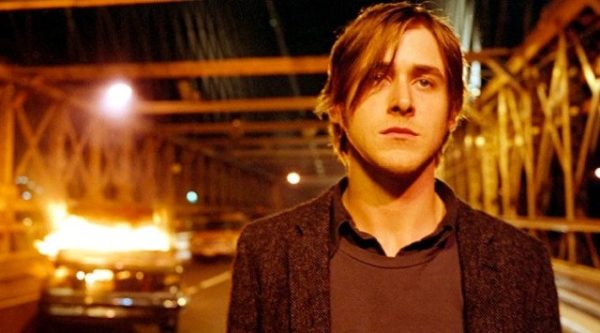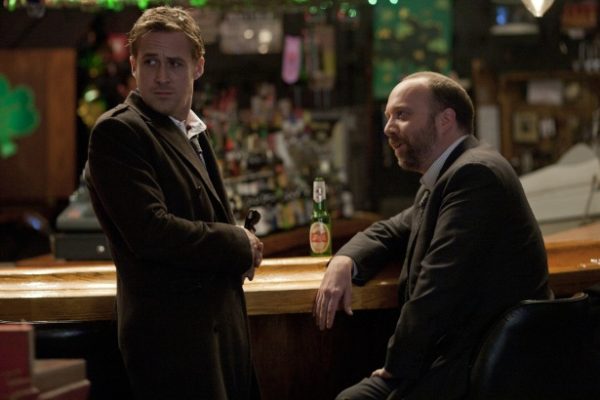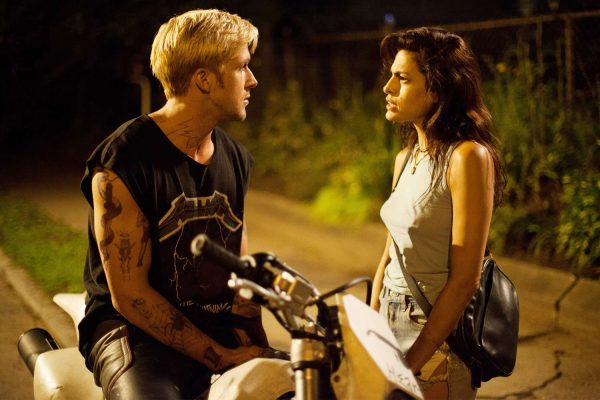This holiday season we’re looking to spread the jolly cheer of one Canadian actor with the 25 days of Ryan Gosling. Each day, this page will be updated with a new movie starring Gosling ranked, from 25 all the way to 1. Ho ho ho!

25 – The Slaughter Rule (2002)
One of Gosling’s earliest starring roles was in this low-budget indie drama which ends up being unfocused and underdeveloped. Gosling plays Roy Churney, a high-school student who, after losing his father, is recruited to a small football team by Coach Gideon (David Morse), who becomes a sort of father figure for the grieving teen. The entire cast feels underdeveloped and though it attempts to comment on some societal issues like homophobia, it refuses to get too deep into them. The film is largely forgettable outside of the bizarre turn of events where Gideon ends up maybe being a pedophile, or at the very least acts very creepy toward his high school players, but it doesn’t really matter because Churney forgives him in the very abrupt and unsatisfying ending.
Rating: (1/5)

24 – All Good Things (2010)
The first of many crime dramas in this list, “All Good Things” is a complete bore and a waste of Gosling and his co-star Kirsten Dunst. The 100-minute movie is a complete drag and feels much longer, especially when not much is really happening outside of a boring love story. The film is framed with some voiceover and a few short scenes in a courtroom where Gosling is dressed in some hilariously bad old man makeup. These scenes don’t even offer much resolution as the man the story was based on, Robert Durst, hadn’t been convicted for the murder that the story focuses on. Far more interesting than anything in the movie is that Durst admired the film so much he offered to be interviewed by director Andrew Jarecki which led to his eventual murder conviction.
Rating: (1/5)

23 – The Gray Man (2022)
There is little to say or remember about “The Gray Man,” mainly because it’s a pile of boring, personality-less slop from some of our worst modern directors, The Russo Brothers. There’s some potential in the action sequences, but they’re all dragged down by awful CGI and filled with digital smoke to try and distract from the bad effects. The Russos also seem to have a special power to drag career-worst performances from every actor they work with—this is likely Gosling’s worst performance on this list.
Rating: (1/5)

22 – Fracture (2007)
“Fracture” is another film with little to write home about. It’s, once again, a flatly-shot Gosling-led crime drama that’s just incredibly generic and forgettable in almost every aspect. The only thing I can remember is when Anthony Hopkins character randomly says, “My dick has evidence,” of course talking about his private investigator whom he refers to as “dick.”
Rating: (2/5)

21 – Stay (2005)
If this was a list of the nuttiest transitions and the most Dutch angles in a movie this would be a clear winner. Unfortunately, “Stay” is mostly concerned with (poorly) emulating other surrealist films while offering little substance. All of its strange moments are nothing but empty buildup to a profound, “crazy” twist ending that’s fairly easy to predict early on. Gosling and co-star Ewan McGregor are pretty good here and the camerawork is genuinely creative but the film ends up a mostly boring, meandering mess; a convoluted film trying to distract you from its hollow core.
Rating: (2/5)

20 – The Notebook (2004)
Teen romance movies all have one thing in common: the male protagonist is best played by Ryan Gosling. Unfortunately, in watching The Notebook you may turn senile with the couple since the nursing home scenes are intolerably boring. I wish I was Allie (Rachel McAdams) so I could forget the bad parts and experience Gosling’s rizz firsthand.
Rating: (2/5)

19 – Gangster Squad (2013)
About as painfully generic and clichéd as you’d expect from a movie with the title “Gangster Squad.” The opening action scene made it seem like it might be at least a somewhat entertaining violent crime thriller, but it ends up predictable and boring, filled with a cast of empty characters. The best part was when a newspaper clipping revealed the team of undercover cops were actually called the “Gangster Squad,” which the real-life police unit the movie is (very) loosely based on also used which feels like a hilariously bad name.
Rating: (2/5)

18 – The United States of Leland (2003)
Gosling and Don Cheadle are quite good in this early 2000s indie drama. Its central conflict is generally engaging and it largely works all the way through its ending. Its main issues are that it tries a little too hard to convince you it’s smarter than it is (Gosling’s character is constantly spouting off some generic existential dialogue to try and convince you it’s deep) and that’s it’s very unfocused, constantly jumping around different characters and flashbacks with many of its subplots not really going anywhere.
Rating: (3/5)

17 – Murder by Numbers (2002)
This is the only movie on this list that has a surprise baboon attack that is never brought up again for the rest of its runtime, which has to count for something. It’s (again) a little generic but it’s fairly entertaining and Gosling along with co-star Michael Pitt are a lot of fun as the dweeb murderers. The biggest issue is that way too much of its runtime is dedicated to executive producer Sandra Bullock, who is by far the least interesting part of the movie.
Rating: (3/5)

16 – The Big Short (2015)
A really interesting story told in the most obnoxious way possible. Adam McKay assembles a great cast here, full of very talented actors (some wasted, like Margot Robbie who appears for one incredibly unfunny joke). The casting and story had the likes to rival “The Wolf of Wall Street,” but fell short as it was not propelled by great directing. “The Big Short” ends up arrogant and righteous, becoming a commentary on capitalism and greed; then transforming into mock remorse that sounds like it came right from the mouths of the benefactors of the housing market crash. The message echoed the saying “Don’t hate the players, hate the game.” If you can get past the first half—the only redeeming part of which was an excess of Christian Bale’s bare feet—and some really bizarre editing, there’s a rewarding second half of the movie that includes Brad Pitt as a schizo-pilled ex-trader and a true-to-life unsatisfactory ending.
Rating: (3/5)

15 – The Believer (2001)
One of Gosling’s earliest roles also happens to be one of his best: here he plays a complex character very well, a man at war with his own identity. Gosling really gives the character the depth needed to keep you engaged. Its primary issue is its filmmaking, which on a technical level is very low-budget and cheap looking, and it probably could’ve used a bit more time in the writers room as parts of this character study feel underdeveloped and short.
Rating: (3/5)

14 – Crazy, Stupid, Love (2011)
This is Gosling’s funniest role; Blue Valentine doesn’t count because despite his haircut and one-liners, the character wasn’t meant to be funny. He and Emma Stone were a couple in “CSL” before “La La Land,” and if you are dying for more, the chemistry is still there! It’s just in a different form; a new-age couple conquering a retail therapy addiction and an unhappy engagement.
Rating: (3/5)

13 – Blue Valentine (2010)
My favorite of all of Gosling’s romance roles. It’s funny for all the sad and wrong reasons, at times it’s heartbreaking. If there weren’t such excessive use of flashbacks it would be higher on the list; we get it, the couple used to be happy. The most redeeming part of the movie is that they feel like a real relationship that just went wrong, which is dually impressive because of a generally out-of-touch scene in Hollywood and that it was made in 2010.
Rating: (3/5)

12 – The Ides of March (2011)
Solid political thrilling with lots of manipulating, blackmailing and backstabbing but nothing too special overall. Hard to hate any movie with Gosling, Hoffman and Giamatti in it. Ends on quite a high note that will give you chills seeing what Gosling’s character will do for political power.
Rating: (3/5)

11 – Barbie (2023)
Likely the best movie Greta Gerwig could’ve made, given that every decision seems to have been meticulously approved by Mattel. The colorful, physical sets are splendid to look at (though it makes the journey to the real world that much more boring and flat-looking). Gosling and Robbie both give very strong performances as well (an early moment on a bench with Robbie is simple but effective). The issue is that Gerwig simply tries to juggle too much: “Barbie” wants to be a fun satire/commentary on gender roles and the patriarchy, a journey of self-actualization through womanhood, a reflection on Barbie’s role in society throughout the years AND a Chevy commercial. The gender commentary ends up being the strongest and funniest part, which has the unfortunate effect of making Gosling’s Ken World, full of its sick horses and musical numbers, the best portion of the movie.
Rating: (3/5)

10 – Half Nelson (2006)
“Half Nelson” is a sad, quiet, reflective film about life as opposing forces. Gosling plays a self-destructive and lonely man trying to force a positive change onto others even if they don’t really need it. He’s a deeply flawed character, one you feel bad for connecting to when he does bad things but can’t help but feel empathy for the pure care he puts into teaching his students. Gosling and co-star Shareeka Epps really make the movie and the shaky, handheld cinematography does a good job of placing you directly into these little moments that make up the film.
Rating: (3/5)

9 – Lars and the Real Girl (2007)
A nice, if somewhat forgettable film that’s much better than the premise might suggest. Gosling plays a lonely man who begins dating a doll, believing her to be his real girlfriend. While the film could’ve been a very surface-level and mildly funny comedy it ended up being a fun and occasionally moving story about mortality, love, acceptance and community.
Rating: (3/5)

8 – The Nice Guys (2016)
“The Nice Guys” has its fair share of issues: the script feels a little underwritten, like it could’ve used a bit more work to tighten up its looser ends, its political motivations feel a bit too broad to really work, and it’s characters often come off as underdeveloped caricatures, which can make it hard to do much else but laugh at them. In the end, I’m willing to forgive a lot of that when you’ve got a movie that’s this frequently funny. Gosling and Crowe make for a great pairing (Gosling is seriously hilarious here, whether it’s falling off buildings or giving a little shriek), the action is solid and even occasionally great and it’s consistently moving so fast you don’t have much time to worry about its flaws.
Rating: (3/5)

7 – La La Land (2016)
Technically great (in a very showy way), with lots of cool whip pans and push-ins and pretty colors to look at. Unfortunately, when I gave “La La Land” a second watch it ended up feeling a little too uneven in almost every other aspect. The songs are generally good, even if the singing in some (like the City of Stars duet) and the dancing on the whole aren’t as good as the old Hollywood musicals the film is attempting to imitate. Overall though, the songs (and the energy in the movie) are so front-loaded and much of the second half drags because of it. The movie feels like it’s spinning its wheels for a while until it reaches the (admittedly incredible) epilogue. While their chemistry is nice, the romance between Gosling and Stone also feels shockingly bland and rushed. The characters end up feeling like broad strokes that are hard to connect to. The message the movie ends on is really fascinating, and I’m glad director Damien Chazelle decided to attempt a twist on this classic romance formula with this push and pull of characters choosing between success and their dreams or the person they love.
Rating: (3/5)

6 – Only God Forgives (2013)
Nicholas Winding Refn’s second collaboration with Gosling is a very silly but engaging piece of film-bro trash. It’s mainly composed of Gosling swapping between three emotions (puppy eyes, thousand-yard stare and screaming) while walking through a series of gorgeously rendered neon-lit paintings, but something about its stylish explorations of mommy issues, the trappings of masculinity and self-destructive violence just work. The film also features some of the finest karaoke you’ll ever see, which is a plus.
Rating: (4/5)

4 – The Place Beyond The Pines (2012)
“The Place Beyond the Pines” is a very fascinating, multi-generational film that takes some swings structurally that I think it mostly hits. Strongly directed by Derek Cianfrance, who last worked with Gosling on “Blue Valentine,” it touches on a lot thematically (fate, fatherhood, the evil of institutions and systems, how far people will go for absolution) that landed with a lot of impact.
Rating: (4/5)

3 – Drive (2011)
Gosling’s other collaboration with Nicholas Winding Refn ends up the stronger of the two. There’s a good reason Gosling driving around to “Nightcall” with that neon aesthetic has ended up so instantly iconic. Another film-bro classic, “Drive” follows Gosling as a quiet weirdo trying to balance this genuine romantic yearning and his brutal, dark violent life of crime. It’s similar thematically to “Only God Forgives,” tracking a group of characters who are all unable to stop their self-destructive paths of violence, unable to stop until they’ve won. Some of Gosling’s best work is in here, including a scene in an elevator that perfectly encapsulates the whole movie (if you’ve seen it, you’ll know).
Rating: (4/5)

2 – First Man (2018)
For Gosling and Damien Chazelle’s second film together, they decided to transform the moon landing into a poignant, deeply sad exploration of grief. The film masterfully depicts how loss permeates every aspect of Neil Armstrong’s life, forcing him to seek solace in the stars and his dreams. Despite achieving a groundbreaking technical feat, the emotional catharsis is fleeting, leaving Armstrong in the vast emptiness of space, haunted by loneliness. The narrative delves into Armstrong’s attempt to cope with the loss of his child through a technical triumph, portrayed with excellent photography through diverse film stocks. The 16mm captures the intensity of flight, immersing viewers in near-death situations, while the 35mm portrays the surface beauty of life at home, and IMAX 70mm shows off the moon’s enormity and desolation. Chazelle’s filmmaking captivates here, making even familiar events where you know the outcome suspenseful.
Rating: (4/5)

1 – Song To Song (2017)
By far the most experimental film on this list, and seemingly one of the last times Gosling would work with a real director, in Terrence Malick, given his recent output (“The Gray Man,” “The Fall Guy”), “Song to Song” was the movie I found myself most connected to and moved by. Its narrative is strung together through Malick’s method of filming hundreds, even thousands of hours of footage and then piecing it together through years in the editing room. “Song to Song” feels so real, like a series of memories being recounted in real-time through the film’s use of voiceover, and the themes of connection and expression (through music and dancing and love) are so masterfully explored. It may not be Gosling’s best performance, due to it being mainly improvisation and voiceover, but it’s definitely Gosling’s best film, a high that it increasingly seems like he will never reach again.





